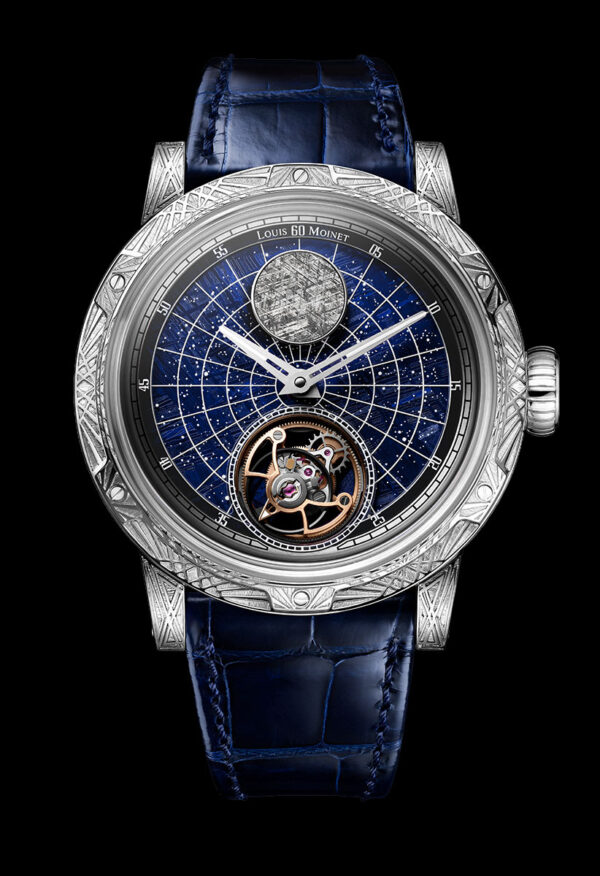18K Red gold
Limited edition of 12 watches
LM-139.50.25
Imagine a watch that shelters the first traces of life ever discovered in the cosmos.
The STARMAN is a watch that might have been named by the stars themselves. It was born of a fascination for the wonders of the cosmos. Limited to just twelve pieces, this horological artpiece combines exceptionally rare meteorites, high technology, and artistic prowess. Each detail reveals a secret, celebrating space through the timeless elegance of haute horlogerie, and it does so day and night…
Calibre LM139
Manufacture Calibre
Manual
28800 VPH (4 Hz)
96 hours
Jewels: 26
47.4 mm
Hours, Minutes

30 metres
Alligator
24 mm
Folding clasp

18K Red gold
Swiss made
Extraterrestrial life
The meteorites that have landed on our planet have travelled billions of kilometers across the mysterious expanse of space.
Each one carries a unique story, one that we are only just beginning to decipher. The STARMAN reveals two of these celestial treasures: the exceptional and rare Jbilet Winselwan, containing the first known traces of life in space, and the fascinatingly structured Gibeon, two meteorites that fuel our dreams of exploration.
Jbilet Winselwan meteorite
The earliest traces of life from space
A fragment of the Jbilet Winselwan meteorite majestically dominates the upper part of the STARMAN’s dial and competes visually with the tourbillon. This beautiful black stone, spangled with little brown dots, was discovered in the western Sahara Desert. It bears amino acids and is thus a silent witness to the first sparks of life spread throughout space.

“Among the treasures of my personal collection are meteorites that have fascinating stories. One in particular, the Jbilet Winselwan, is noted for the presence of amino acids, molecules that are considered the building blocks of life itself. I was fascinated by these traces of life in space, so this year I decided to incorporate a fragment of that meteorite in a timepiece with a name that came quite naturally: STARMAN. This watch, which is the product of some remarkable horological techniques, has many other secrets to reveal…”
Jean-Marie Schaller
CEO & CREATIVE DIRECTOR
The STARMAN dial
a highly complex construction
The STARMAN’s dial is a genuine feat of artistic and technical prowess. Let’s begin with the base cut from the Gibeon meteorite, which fell to earth in prehistoric times and is famous for its emblematic Widmanstätten pattern. The fragment was dyed in a deep blue using an intricate – and secret – process. A second disc made of sapphire crystal features a map of the stars. In the foreground are the constellations carefully painted by hand using a luminescent material. They appear on the backdrop of the map’s longitudinal and latitudinal lines.
At night, the STARMAN reveals a magnificent stellar panorama, creating an appearance of depth that draws us into the immensity of the universe itself. This nightly display is enhanced by the vibrant blue hands and indexes that provide a touch of technical elegance to this exceptional timepiece.
The Gibeon meteorite, which fell to earth in prehistoric times, is famous for its emblematic Widmanstätten pattern.
The art of horology
The STARMAN defies gravity in a riveting manner thanks to its flying tourbillon in an off-centre cage. The hand-wound movement is equipped with two barrels in parallel. The system, called “volte face,” has one of the barrels turned upside-down or head-to-tail, so they deliver their energy simultaneously, producing a power reserve of ninety-six hours.
It comes in an 18-carat gold case with a diameter of 47.4 millimetres. Its architecture is opulent and complex, mixing brushed and polished surfaces and a stepped bezel that gives it a unique character.


The solar map and its riddle
Turn the STARMAN around, you will find a fascinating chart of the solar system. The planets, some of which only measure two millimetres in diameter, have been meticulously painted by hand and placed on a grid that seems to float over a star-lit sky.
The ultimate secret, however, is this: The planets have been precisely positioned as they appeared on March 21, 2013, when the world of watchmaking was stunned by an amazing revelation: Louis Moinet was the inventor of the chronograph. The public event was held at the Neuchâtel observatory, where Jean-Marie Schaller unveiled the famous compteur de tierces, which had been built by the great French watchmaker in 1816.
Honouring a unique moment
Upon request, the craftspeople at Louis Moinet can also personalise the watch by positioning the planets to tell a specific date. This is a unique way to immortalise a very special moment on the backdrop of a starry sky, a date that will only be known to the owner of the watch.










